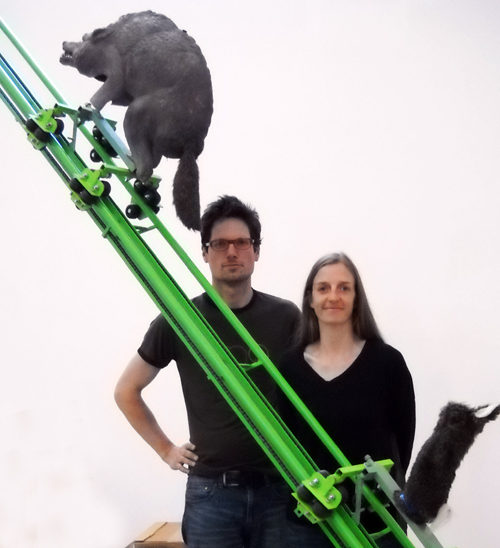
He’s not an artist, at least not in the fine art sense. Rodger Tschanz spends his time growing flowers and other plants as the manager of U of G’s trial gardens.
But look closely at a current installation at the Macdonald Stewart Art Centre (MSAC) exploring our relationship with nature and landscape, and you can see evidence of Tschanz’s green thumb.
Opened in early May, promised lands occupies the entire ground floor of the art centre. The kinetic installation is the handiwork of Toronto artist Robert Hengeveld, artist-in-residence at U of G’s School of Environmental Sciences (SES) for 2011-14.
The show is guest curated for MSAC by Julie René de Cotret, who was Hengeveld’s predecessor as the school’s inaugural artist-in-residence.
Opened at the beginning of May, the exhibit continues until mid-July.
Separate pieces located throughout the centre’s main-floor galleries look at human desires — for love, appreciation, control, more money, a better job – under the theme of promises.
Promises may be delivered or withheld or otherwise subverted, says Hengeveld. And, as in this show, they may take the form of hopes – whether thwarted or not – for control of our surroundings.
You first encounter howl, a neon-green rollercoaster in the central gallery. Looping around the track are not cars but a stuffed rabbit and a stylized plastic coyote. Originally designed for Nuit Blanche in Toronto last fall, the piece has been reworked for this show, says Hengeveld.
At first glance, the coyote appears to be chasing the rabbit, echoing the natural order of things, he says. But it’s unclear just who is chasing whom, particularly when the artist points out that both creatures are physical decoys used for opposing reasons.
The rabbit is an actual hunter’s decoy for attracting predators. The coyote is normally used scarecrow-like for deterring other creatures. Whether luring or warding off animals, the notion of manipulating prey and predator evokes questions about our efforts to control our environment, he says.
That notion runs through the rest of his exhibit.
There’s plenty of whimsy in an installation called in pursuit of paradise. In one gallery, Hengeveld has installed an elevator in a temporary wall. Through some artistic sleight of hand — and more than a bit of electrical and mechanical knowhow – his elevator delivers the visitor into a diorama of a campsite at night.
“Soon after this show, he’s going to get an honorary degree,” quips René de Cotret. “He’s more an inventor than an engineer.”
Visitors walk through a setting designed to mimic a pond, rock walls and a campfire, with recorded bird calls and LED lights flashing in approximation of fireflies.
Artifice and reality force the viewer to think about his or her experience of nature, says René de Cotret. “In other places, you walk into the space. Here, you are moved into the space. It is divulged, it’s more immersive. You can experience that synthetic re-creation of that awe of nature and evaluate it.”
For more than a few gardeners, maintaining a lawn comes close to the ultimate effort to control nature. Exploring that effort – and the possibilities of unfulfilled promise or even outright failure – is the point of unbridled rein.
Here a CNC-controlled machine looks after a tabletop “lawn.” The piece contains real grass grown in landscaping fabric and watered periodically by automated equipment; artificial lighting mimics day-night cycles. An automated “lawn mower” – small blades on a mechanical arm – is intended to keep the turf trimmed.
Looking for help in creating his turf tabletop, Hengeveld found Tschanz in the Department of Plant Agriculture.
Using actual sod would have been a greater challenge, says Tschanz. Instead, he grew species obtained from the Guelph Turfgrass Institute on specially designed felt that anchors grass roots and holds water and nutrients in capillaries.
Describing it as a form of hydroponics, Tschanz says, “It’s just a light, transportable turf form that you can lay like carpet.”
This wasn’t his first grass art project. Working with René de Cotret during her 2010-11 residency, he used another hydroponic setup — paper impregnated with seed – to cover a chair.
Hengeveld’s project contains a species of bentgrass that should resist disease and require less maintenance than other kinds of turf. Still, the artist says the installation might well fail because of too much or too little water or light or even through over-trimming.
He’s sanguine about that prospect and about what it might say about the quest for perfection. “Failure is part of experimentation. If the grass is dead, the mower still tries to maintain it.”
Says Tschanz, “It’s a statement on how involved some aspects of turf management are.”
He’s okay with what some gallery-goers might perceive as a comment on his own workaday maintenance routines as a horticulturalist.
Besides, he has his own take on perfection and failure. “Halfway through, if he needs to reinstall the grass, maybe the light intensity is not high enough to keep it healthy, we’re trying to grow a backup piece of grass for him.”
The exhibit is organized by MSAC, SES and Plant Agriculture, with support from Hallwalls Contemporary Arts Centre in Buffalo, New York, the Canada Council for the Arts and the Ontario Arts Council.